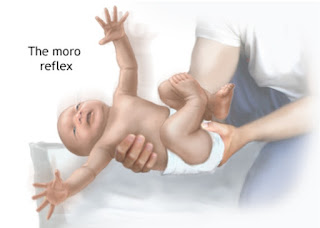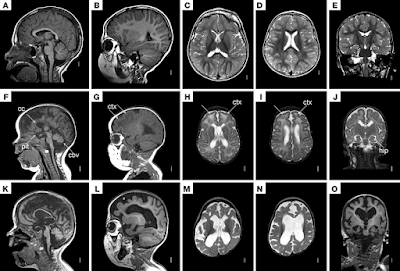When a baby is born, their tiny body is equipped with several reflexes that help them adapt to life outside the womb. These reflexes, which are automatic responses to specific stimuli, play a vital role in their survival and development. Understanding these reflexes can provide valuable insights into your baby’s neurological health and development.
This blog will delve into the various reflexes seen in newborns, their significance, and what parents should expect during their baby's first year of life.
What Are Reflexes in Babies?
Reflexes in babies are involuntary actions triggered by external stimuli. These responses are controlled by the brainstem and spinal cord, indicating that they are innate rather than learned behaviors. Reflexes are categorized as:
- Primitive reflexes: Present at birth and gradually disappear as the baby matures.
- Postural reflexes: Develop later and help the baby gain control over their movements.
Key Primitive Reflexes in Newborns
1. Rooting Reflex
What It Is: When you gently stroke a baby’s cheek or mouth corner, they turn their head in that direction and open their mouth.
Purpose: Helps the baby locate and latch onto the breast or bottle for feeding.
Disappearance: Around 4 months of age.
2. Sucking Reflex
What It Is: When the roof of a baby’s mouth is touched, they instinctively start sucking.
Purpose: Essential for feeding and nutrition.
Disappearance: Integrates into voluntary sucking by 4 months.
3. Moro Reflex (Startle Reflex)
What It Is: When a baby is startled by a loud noise or sudden movement, they throw their arms out, arch their back, and then bring their arms back in.
Purpose: Thought to be a protective response.
Disappearance: By 5-6 months.
4. Palmar Grasp Reflex
What It Is: When you place a finger or object in a baby’s palm, they close their hand tightly around it.
Purpose: Possibly an evolutionary remnant related to grasping for safety.
Disappearance: Around 5-6 months.
5. Plantar Grasp Reflex
What It Is: Pressing a finger against the sole of a baby’s foot causes their toes to curl.
Purpose: Precursor to walking and balance.
Disappearance: By 9-12 months.
6. Tonic Neck Reflex (Fencer’s Pose)
What It Is: When a baby’s head is turned to one side, the arm on that side extends, and the opposite arm bends.
Purpose: May assist in hand-eye coordination development.
Disappearance: Around 5-7 months.
7. Stepping Reflex
What It Is: Holding a baby upright with their feet touching a surface causes them to make stepping motions.
Purpose: Prepares the baby for walking later.
Disappearance: By 2 months but reappears as voluntary walking around 12 months.
8. Babinski Reflex
What It Is: Stroking the sole of a baby’s foot results in their toes fanning out and the big toe pointing upward.
Purpose: Indicates normal neurological function.
Disappearance: Around 12 months.
Why Are Reflexes Important?
Reflexes serve multiple purposes in a baby's development, including:
1. Survival: Reflexes like rooting and sucking ensure the baby can feed.
2. Neurological Health Assessment: Pediatricians assess reflexes to check for normal brain and nerve function.
3. Motor Development: Reflexes lay the foundation for voluntary movements like crawling, standing, and walking.
When to Be Concerned
While most reflexes are normal and part of a baby's development, certain signs may indicate an issue:
- Reflexes persisting beyond the expected age.
- Absence of reflexes in newborns.
- Asymmetry in reflex responses (e.g., Moro reflex active only on one side).
If you notice any of these signs, consult your pediatrician for further evaluation.
Postural Reflexes: The Next Stage
As primitive reflexes fade, postural reflexes start to emerge. These reflexes help the baby develop balance, coordination, and motor skills. Examples include:
- Parachute Reflex: Appears around 6-9 months; the baby extends their arms to break a fall when tilted forward.
- Landau Reflex: When held horizontally, the baby arches their back and raises their head and legs.
Encouraging Reflex Integration
Parents can support their baby's reflex development with:
- Tummy Time: Strengthens neck and shoulder muscles, aiding in motor development.
- Interactive Play: Stimulates reflexes like grasping and stepping.
- Gentle Stimulation: Encourages reflexive movements that prepare the baby for voluntary actions.
Reflexes and Milestones: What to Expect
Reflexes transition into milestones as your baby grows:
By 3-4 months, primitive reflexes start to fade.
By 6-12 months, babies begin to exhibit postural reflexes.
By 12 months, reflex integration supports milestones like walking and balance.
Every baby develops at their own pace, so it’s important to observe trends rather than fixate on specific timelines.
Final Thoughts
Reflexes in babies are more than just fascinating behaviors; they are vital indicators of health and development. By understanding these reflexes, parents can better appreciate their baby’s growth journey and spot any potential concerns early on.
Celebrate these milestones and consult your pediatrician regularly to ensure your baby is on the right track. From their first grasp to their first steps, every reflex and movement is a testament to the incredible growth happening in your little one’s body.
Frequently Asked Questions (FAQs)
1. What if my baby’s reflexes disappear early?
Reflex disappearance slightly earlier than average is usually normal, but consult your doctor if you're concerned.
2. Can reflexes reappear after disappearing?
Yes, certain reflexes may temporarily reemerge if the baby experiences neurological stress.
3. How do doctors test reflexes in babies?
Doctors gently stimulate specific areas to observe reflexive responses during routine checkups.
Understanding your baby's reflexes equips you to enjoy every step of their developmental journey with confidence and curiosity.










.jpeg)
.jpeg)




.jpeg)
.jpeg)

0 Comments